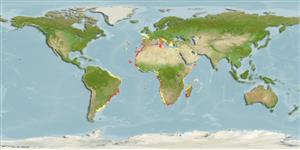Classification / Names
Common names from other countries
Main reference
Size / Weight / Age
Max length : 150 cm TL male/unsexed; (Ref. 12382); max. published weight: 60.0 kg (Ref. 5222); max. reported age: 50 years (Ref. 12382)
Length at first maturity
Lm 47.0 range ? - ? cm
Environment
Marine; reef-associated; depth range 8 - 300 m (Ref. 27000), usually ? - 50 m (Ref. 5222)
Climate / Range
Subtropical, preferred 26°C (Ref. 107945); 54°N - 43°S, 65°W - 58°E (Ref. 5222)
Distribution
East and Southwest Atlantic and Western Indian Ocean: East Atlantic: throughout the Mediterranean Sea, and from the southern Bay of Biscaye to southern tip of Africa. Stray specimens reported from the British Isles, and eastern English Channel (Normandy, France; Ref. 92236). Southwest Atlantic: southeastern Brazil, Uruguay, and Argentina. Western Indian Ocean: from tip of Africa to southern Mozambique and southern Madagascar. Reported from Oman and La Reunion I.
Countries | FAO areas | Ecosystems | Occurrences | Introductions
Short description
Dorsal
spines
(total): 11;
Dorsal
soft rays
(total): 14-16;
Anal
spines: 3;
Anal
soft rays: 8 - 9. Diagnosis: head and body dark reddish brown or greyish dorsally, usually yellowish gold ventrally; irregular white, pale greenish yellow or silvery grey blotches usually visible on the body and head and mostly arranged in vertical series; more or less distinct black maxillary streak; dark brown median fins; distal edge of anal and caudal fins, often also pectoral fins, narrowly white; pelvic fins blackish distally; pectoral fins dark reddish brown or grey; margin of spinous dorsal fin and basal part of the paired fins often golden yellow; head length 2.3-2.5 in SL; convex interorbital area; rounded preopercle, finely serrate, serrae at angle slightly enlarged; smooth subopercle and interopercle; eye diameter greater than or subequal to interorbital width in fish 10-30 cm SL, less than interorbital in fish over 40 cm SL; posterior and anterior nostrils subequal or posterior nostril slightly larger; maxilla naked, reaching to or slightly past vertical at rear edge of eye; 2-4 rows of subequal teeth on midlateral part of lower jaw (Ref. 89707).
IUCN Red List Status (Ref. 115185)
Threat to humans
Harmless
Human uses
Fisheries: highly commercial; gamefish: yes
Tools
Special reports
Download XML
Internet sources
Estimates of some properties based on models
Phylogenetic diversity index
PD50 = 0.5000 many relatives (e.g. carps) 0.5 - 2.0 few relatives (e.g. lungfishes)
Trophic Level
4.4 ±0.0 se; Based on diet studies.
Resilience
Low, minimum population doubling time 4.5 - 14 years (K=0.03-0.09; tmax=50; tm=7)
Vulnerability
High to very high vulnerability (72 of 100)
Price category
